Saudi Arabia privatises state assets and strengthens sovereign wealth fund
The foundations for a major overhaul of the economy were laid during 2017, with the Saudi government taking steps to privatise key state assets and stimulate investment, as part of plans to diversify the economy away from a reliance on hydrocarbons revenues.
Strong Returns
The reforms came as the non-oil economy gained some momentum in the second half of 2017. After falling by 0.8% in the first six months, year-end GDP growth was expected to be -0.5%, according to the Ministry of Economy and Planning, down from last year’s rate of 1.7%. The negative growth has been driven by Saudi Arabia’s commitment to cut oil output in line with the recently extended OPEC agreement. However, non-oil growth, which reached 1.5%, is estimated to offset an anticipated 4.3% contraction in the oil sector.
The country’s fiscal position has continued to strengthen, with Ministry of Finance data showing the deficit for 2017 to be SR230bn ($61.3bn) or 8.9% of GDP, a 25.9% reduction over 2016. While state outlays have increased by 11.6% in 2017, the fiscal improvement is largely due to a 33.9% rise in total revenue. This has been driven by an increase in oil returns, which have grown by 32% to SR440bn ($117.3bn) on the back of an uptick in global demand and higher prices, despite falling 8% short of year-end energy earnings targets of SR480bn ($128bn) for 2017.
The economy has also been boosted by an increase in non-oil earnings, which rose by 38% in 2017 due to the implementation of several fiscal reforms over the course of the year. The government’s efforts to stimulate growth in this sector appear to be bearing fruit, with non-oil revenue from taxes jumping by 18.6% over the year, mostly driven by a 54% increase from taxes on goods and services due to the introduction of excise taxes and new visa fees in the second half of 2017. Of non-oil revenue, the “other revenue” segment, which includes returns from governmental entities like the Saudi Arabian Monetary Authority (SAMA) and the Public Investment Fund (PIF), rose by 36.8% in 2017.
Privatisation
Saudi Arabia took a significant step forward in its strategy to diversify the economy, with the announcement of plans to strengthen the sovereign wealth fund and privatise key state assets. In late October 2017 the government launched the PIF Programme 2018-20, which aims to develop the PIF into the largest sovereign wealth fund in the world, driving investment into the economy. The investment fund is hoping to increase assets under management from $230bn in 2017 to $400bn by 2020, and then expand the figure further to $2trn by the year 2030.
The government has also made progress with its wider privatisation programme, which aims to raise $300bn through the sale of state assets for reinvestment by the PIF and other agencies. In July 2017 Mohammed Al Tuwaijri, the minister for economy and planning, announced that moves were under way to sell the state-owned power generation firm and water desalination company, among others.
Meanwhile, in late November the same year Saudi Aramco signed a memorandum of understanding with chemicals producer SABIC, a move that is likely to broaden its appeal to investors ahead of the scheduled public listing of 5% of its shares in 2018. The agreement relates to the development of a $20bn, fully integrated crude oil-to-chemicals complex, which will have the capacity to process 400,000 barrels per day of oil and produce 9m tonnes of chemicals and base oils annually when it is brought on-line in 2025. The plant is also expected to create an estimated 30,000 jobs and contribute 1.5% to the country’s GDP by 2030.
The downstream investment is set to be the first of several, according to company officials, with the move into petrochemicals part of government attempts to diversify the economy’s revenue generation beyond exporting crude oil. This plan to broaden the base of the economy will be supported by Saudi Arabia’s 2018 budget – the country’s largest ever – which outlines an increase in public spending and a slowing of austerity.
You have reached the limit of premium articles you can view for free.
Choose from the options below to purchase print or digital editions of our Reports. You can also purchase a website subscription giving you unlimited access to all of our Reports online for 12 months.
If you have already purchased this Report or have a website subscription, please login to continue.

